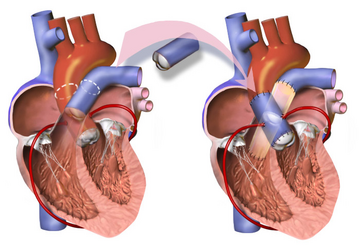Operation according to Ross
The Ross procedure (short Ross-OP , engl. Ross procedure ) a heart surgery , in which a degenerate aortic valve through the patient's own healthy pulmonary valve is replaced. Instead of this, a donor preparation ( allograft ) is implanted. The operation is performed with good success in children, while the results are more controversial in adults. The lack of a need for coagulation inhibition ( anticoagulation ), as in the case of an artificial valve replacement, is advantageous , since no foreign material is implanted, and better hemodynamic properties. A disadvantage is often formulated that the disease of one heart valve requires an operation on two valves.
history
In an animal experiment in 1960, Lower implanted the pulmonary valve in the ascending aorta and Pillsbury in 1966 in the aortic valve root. A year later, Donald Ross , after whom the procedure is named, succeeded in creating the first clinical aortic valve replacement with an autologous pulmonary valve. Due to the complexity of this operation on the one hand and the rapidly developing, easy-to-implant mechanical replacement valves and bioprostheses on the other , the Ross operation was initially not widely used. It was only through the publication of excellent clinical results at the end of the 1980s and the increasingly obvious disadvantages of conventional replacement valves that this method became more attractive.
Since 1987 there has been an increase in the number of operations worldwide from an initial 30 interventions per year to over 600 in 1996. The total number of Ross operations by mid-2003 was around 5500.
Individual evidence
- ^ Lower RR, Stofer CR, Shumway NE: A study of pulmonary valve autotransplantation. In: Surgery 1960; 48: 1090-1100.
- ^ Pillsbury RC, Shumway NE: Replacement of the aortic valve with the autologous pulmonic valve. In: Surg Forum 1966; 17: 176-177.
- ^ Ross DN: Homograft replacement of the aortic valve. In: The Lancet . 1962 Sep 8; 2 (7254): 487. PMID 14494158
literature
- Takkenberg JJ et al .: The Ross procedure: a systematic review and meta-analysis. In: Circulation . 2009 Jan 20; 119 (2): 222-8. Review. PMID 19118260
- H. Sievers et al .: The Ross operation - a therapy option for aortic valve diseases: Results of the German Ross Register In: Dtsch Arztebl 2005; 102 (30): A-2090 / B-1763 / C-1667
